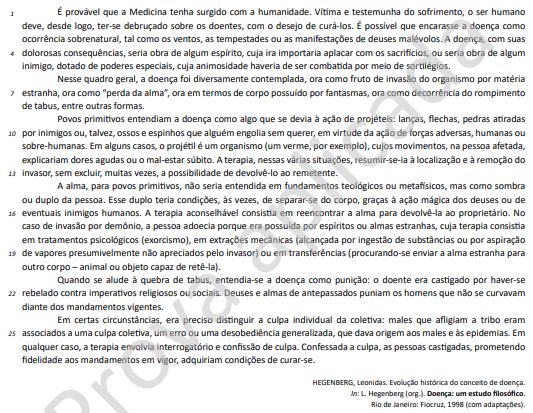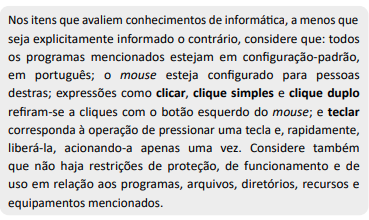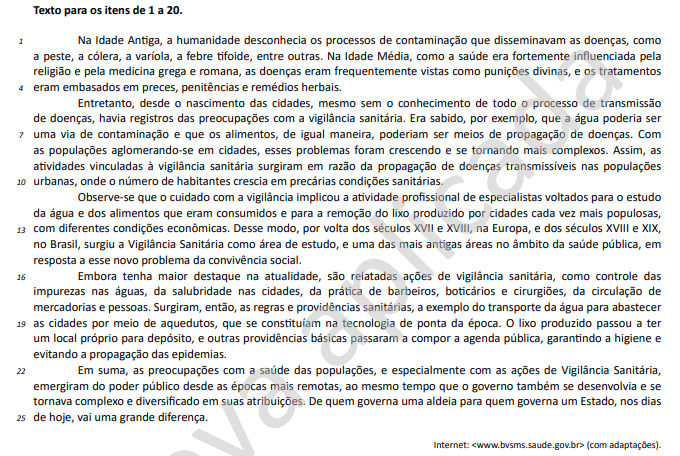A expressão “tal como” (linha 3) poderia, sem prejuízo gramatical, ser flexionada no plural – tais como –, caso em que passaria a se referir aos elementos da enumeração posterior.
Em relação ao programa de navegação Google Chrome, em sua versão mais recente, às noções de vírus, worms e pragas virtuais e aos aplicativos para segurança da informação, julgue o item a seguir.
Uma das formas de compartilhar páginas no Google Chrome com as pessoas usando outros aplicativos é por meio de um QR code.
No computador, a principal função de uma placa de rede é melhorar o desempenho gráfico do computador, processando imagens e vídeos em alta resolução.
No que diz respeito às medidas tomadas pelo atual presidente norte-americano, julgue o item seguinte.
Na escala de nações, a maior população de migrantes do mundo encontra-se nos Estados Unidos da América (EUA).
Acerca dos atendimentos médicos realizados em uma unidade básica de saúde (UBS), julgue o item seguinte
A Portaria nº 204/2016 inclui a sífilis congênita na lista de doenças de notificação compulsória.
In the early 2000s, when Amazon introduced its Kiva robots to automate warehouse operations, employees feared for their jobs as machines began taking over tasks previously performed by humans. Today, advances in gen AI and natural language processing, such as ChatGPT, are transforming many industries and raising similar concerns. However, unlike past automation technologies, gen AI has the unique potential to impact all job sectors, particularly given its fundamental ability to improve its capabilities over time – which promises to affect the workforce in ways that go beyond simple job replacement.
In new research, forthcoming in Management Science, we explore the impact gen AI has already had on the labor market by examining trends in demand for online freelancers. Our findings show significant short‑term job replacement after these tools were introduced, and that jobs prone to automation, like writing and coding, were the most affected by ChatGPT.Our research also examines how competition, job requirements, and employer willingness‑to‑pay have changed to better understand how the online job market is evolving with the rise of gen AI. Although still in its early stages, gen AI’s impact on online labor markets is already becoming discernible, suggesting potential shifts in long‑term labor market dynamics that could bring both challenges and opportunities.
To conduct our study, we analyzed 1.388.711 job posts from a leading global online freelancing platform from July 2021 to July 2023. Online freelancing platforms provide a good setting for examining emerging trends due to the digital, task‑oriented, and flexible nature of work on these platforms. We focus our analysis on the introduction of two types of gen AI tools: ChatGPT and image‑generating AI. Specifically, we wanted to understand whether the introduction and diffusion of these tools decreased demand for jobs on this platform and, if so, which types of jobs and skills are affected most and by how much.
Using a machine learning algorithm, we first grouped job posts into different categories based on their detailed job descriptions. These categories were then classified into three types: manual‑intensive jobs (e.g., data and office management, video services, and audio services), automation‑prone jobs (e.g., writing; software, app, and web development; engineering), and image‑generating jobs (e.g., graphic design and 3D modeling). We then examined the impact that the introduction of Gen AI tools had on demand across these different types of jobs.
We find that the introduction of ChatGPT and image‑generating tools led to nearly immediate decreases in posts for online gig workers across job types, but particularly for automation‑prone jobs. After the introduction of ChatGPT, there was a 21% decrease in the weekly number of posts in automation‑prone jobs compared to manual‑intensive jobs. Writing jobs were affected the most (30.37% decrease), followed by software, app, and web development (20.62%) and engineering (10.42%).
Internet: www.hbr.org (adapted).
The expression “short-term job” (second paragraph) means well established jobs, regarding long careers.
In the early 2000s, when Amazon introduced its Kiva robots to automate warehouse operations, employees feared for their jobs as machines began taking over tasks previously performed by humans. Today, advances in gen AI and natural language processing, such as ChatGPT, are transforming many industries and raising similar concerns. However, unlike past automation technologies, gen AI has the unique potential to impact all job sectors, particularly given its fundamental ability to improve its capabilities over time – which promises to affect the workforce in ways that go beyond simple job replacement.
In new research, forthcoming in Management Science, we explore the impact gen AI has already had on the labor market by examining trends in demand for online freelancers. Our findings show significant short‑term job replacement after these tools were introduced, and that jobs prone to automation, like writing and coding, were the most affected by ChatGPT.Our research also examines how competition, job requirements, and employer willingness‑to‑pay have changed to better understand how the online job market is evolving with the rise of gen AI. Although still in its early stages, gen AI’s impact on online labor markets is already becoming discernible, suggesting potential shifts in long‑term labor market dynamics that could bring both challenges and opportunities.
To conduct our study, we analyzed 1.388.711 job posts from a leading global online freelancing platform from July 2021 to July 2023. Online freelancing platforms provide a good setting for examining emerging trends due to the digital, task‑oriented, and flexible nature of work on these platforms. We focus our analysis on the introduction of two types of gen AI tools: ChatGPT and image‑generating AI. Specifically, we wanted to understand whether the introduction and diffusion of these tools decreased demand for jobs on this platform and, if so, which types of jobs and skills are affected most and by how much.
Using a machine learning algorithm, we first grouped job posts into different categories based on their detailed job descriptions. These categories were then classified into three types: manual‑intensive jobs (e.g., data and office management, video services, and audio services), automation‑prone jobs (e.g., writing; software, app, and web development; engineering), and image‑generating jobs (e.g., graphic design and 3D modeling). We then examined the impact that the introduction of Gen AI tools had on demand across these different types of jobs.
We find that the introduction of ChatGPT and image‑generating tools led to nearly immediate decreases in posts for online gig workers across job types, but particularly for automation‑prone jobs. After the introduction of ChatGPT, there was a 21% decrease in the weekly number of posts in automation‑prone jobs compared to manual‑intensive jobs. Writing jobs were affected the most (30.37% decrease), followed by software, app, and web development (20.62%) and engineering (10.42%).
Internet: www.hbr.org (adapted).
Artificial Intelligence impacts have already affected the labor market.
Com relação à legislação sanitária e à fiscalização, julgue o item seguinte
A Lei nº 9.782/1999 define a ANVISA como autarquia responsável pelo controle sanitário.
Acerca das memórias de computador, da arquitetura de processadores e dos barramentos de entrada e saída, julgue o item a seguir.
A arquitetura Harvard utiliza uma única via para instruções e dados, o que permite que as operações de leitura de dados e instruções ocorram simultaneamente.
A respeito da propaganda e da publicidade médica, julgue o item a seguir
A Resolução CFM nº 2.336/2023 permite que o médico divulgue informações sobre sua formação acadêmica e títulos reconhecidos.
Com relação à legislação sanitária e à fiscalização, julgue o item seguinte
Médicos podem exercer atividades em clínicas não registradas no CRM, desde que possuam registro regular.
A respeito da propaganda e da publicidade médica, julgue o item a seguir
A publicidade médica deve preservar o prestígio da profissão e não pode se valer de artifícios que possam iludir o paciente.
No que diz respeito à saúde suplementar, julgue o item a seguir
Planos de saúde não podem cobrir apenas doenças predefinidas em contrato, devendo atender condições emergenciais.
A respeito do SUS e dos modelos assistenciais, julgue o item seguinte
A taxa de mortalidade materna inclui óbitos ocorridos durante a gestação, parto e puerpério, não apenas durante o parto.
Acerca da estruturação linguístico-gramatical do texto, julgue o item a seguir.
Sem prejuízo à correção gramatical ou ao sentido original do texto, a sentença “Na Idade Média, como a saúde era fortemente influenciada pela religião e pela medicina grega e romana, as doenças eram frequentemente vistas como punições divinas, e os tratamentos eram embasados em preces, penitências e remédios herbais.” poderia ser assim reescrita: Como a saúde sofria veemente influência pela religião e pelas medicinas grega e romana, no Medievo, tratavam‑se das doenças como preces com punições divinas, e os tratamentos eram em forma de preces, purificações e remédios alopáticos.




